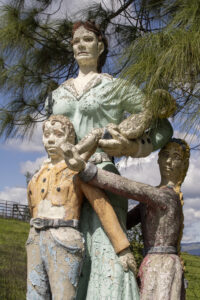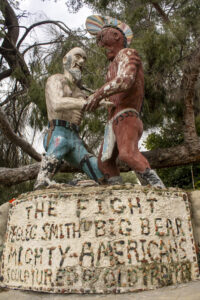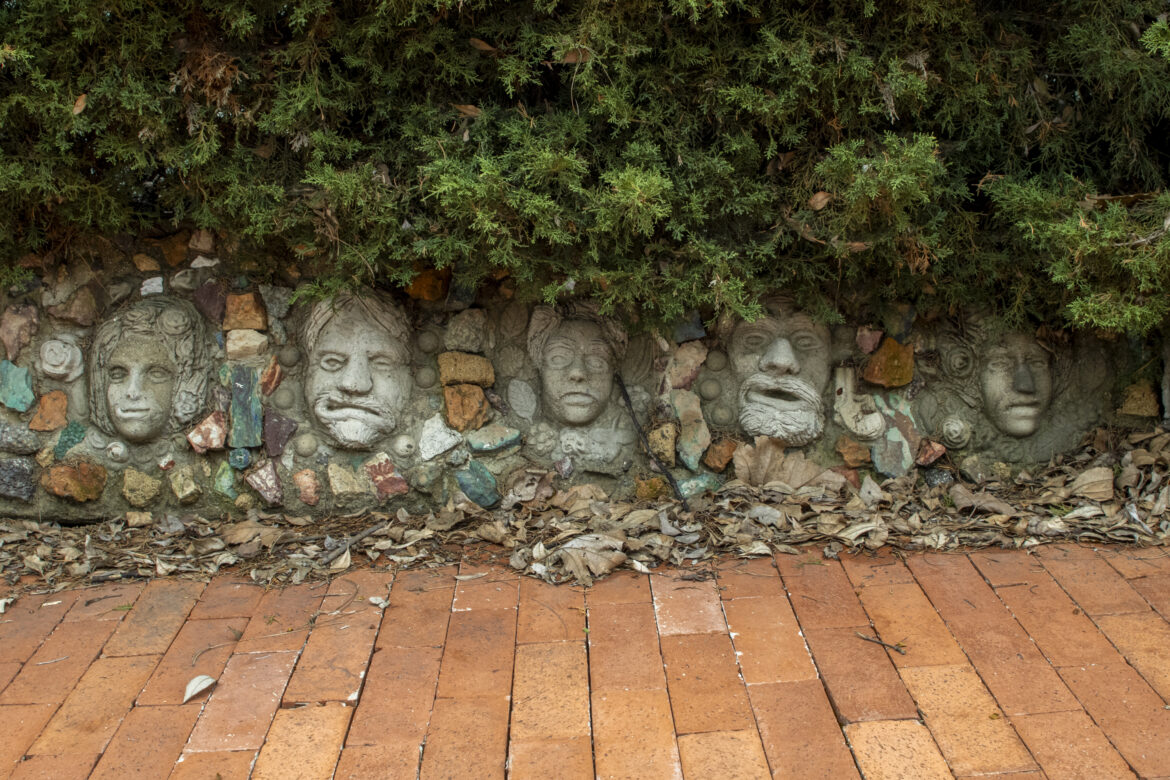There’s a California Historical Landmark on the Pierce College campus—but most students don’t know about it, and many of those who do are not happy about it.
Old Trapper’s Lodge is a folk art installation and California Historical Landmark (no. 939). It was completed in 1981 by John Ehn for his family’s motel, the same year in which he died. In 1988, the motel was bought by Burbank Airport to clear space for a longer runway, according to an appraisal commissioned by Pierce in 2021.
The motel was demolished, but an organization called SPACES (Saving Preserving Arts Cultural Environments) worked with the Ehn family to find a new home for the installation.
In the late 1980s, SPACES asked multiple organizations to house the exhibit, including the L.A. Zoo and Knott’s Berry Farm. Both rejected the offer.
In 1988, then-President of Pierce David Wolf signed the agreement to bring the installation to Pierce, which stated, “It is with pleasure that I, on behalf of Los Angeles Pierce College, accept Historical Landmark #939, also known as John Ehn’s Old Trappers Boothill.”

The president and board at the time likely did not know how attitudes of what is and is not acceptable as folk art would evolve in the coming decades.
“These large figurative sculptures no longer garner sympathy nor admiration; indeed, they are considered offensive because of their stereotypical racial and misogynist message towards Native Americans, people of color and women,” was written on page 18 of the appraisal.
The folk art sculptures depict stereotypes of the Old West, including a Native American person kidnapping a white woman and a knife fight between caricatures of a settler and a Native American man.
In recent years, Old Trapper’s Lodge has received backlash over what is seen as a racist representation of Native Americans.

Pierce history professor Brian Walsh shares this concern.
“It just serves as a reminder of what a racist country this one is because this is from the ’50s,” Walsh said. “This is not from the late 1800s, this was built in the 1950s to commemorate this sort of John Wayne, cowboys and Indians view that you see in T.V. and movies of the savage Indian.”
Not everyone shares this view. Esotouric is a company that leads tours of Southern California’s more odd and lesser-known attractions and has been leading the charge to preserve the folk art.
Esotouric is owned by husband-and-wife Richard Schave and Kim Cooper, who have documented on their website efforts to keep Old Trapper’s Lodge open.
According to Cooper, some pieces depict violence, but visitors could be informed beforehand of the content via signage if they do not want to continue into the area to see those pieces.
“The style of the art is primitive Americana themed folk art, and there’s no reason this type of art should not be on a college campus,” Cooper wrote in an email. “The subject matter of two of the large pieces is violence in the Old West, which can be disturbing to some viewers. Nobody should have to look at any artwork they don’t want to look at. However, this location is notoriously hard to find, and a very small part of an enormous campus.”
Cooper believes interpretive signage to explain the context of the sculptures should be added at the entrance to Old Trapper’s Lodge.
When the statues were relocated to Pierce in 1988, the college and the Ehn family had agreed to written conditions under which the installation was to be donated. Included was protocol if moving the statues from campus was necessary.
“Under no circumstances is the ‘Boothill’ to be destroyed or disposed of unless every effort has been made to contact the donors. If they are unavailable a sincere, diligent effort must be made to find a safe new home for the “Boothill”. As a last resort the artifacts can be separated and given to various Folk Art museums, etc. This should be handled by the SPACES organization if they are still in existence. Priority should be given to organizations in Southern California. All current restrictions and agreements are to remain in effect with the new recipients. If Pierce College cannot find a proper site the Ehn Family retains the right to take back the sculptures,” the Ehn family wrote in a document outlining their conditions.
SPACES is “no longer active,” according to page 17 of the appraisal.
In 2022, Pierce reached out to Tommy Gelinas, founder of Valley Relics Museum, who agreed to take the folk art.
Esotouric opposed the way the deinstallation process was being done by Valley Relics to move it, and they found it “deeply disturbing.”
Gelinas at Valley Relics had initially been contacted by Walsh about the folk art.
“They made a deal. We got through the bureaucratic thicket of the state landmark designation, got through the obligations the district had. Once that’s clear, then you just need to get a truck,” Walsh said. “Esotouric created such a hassle and such a headache for Tommy and Valley Relics he said it’s just not worth it. All they had to do was nothing. Why would they force them to be in a place where they are not welcome?”
The appraisal details two options for handling the installation—recontextualization and treatment before deinstallation. One local art lab provided an estimate of $76,150 to prepare the artwork for deinstallation and transportation, according to the appraisal. It would cost an additional estimated $157,390 to deinstall, crate and transport the collection.
Four options for the future of Old Trapper’s Lodge were discussed on page 25 of the same report—storage/relocation, recontextualization, reconciliation and digital documentation.
In an interview in February, Pierce Interim President Ara Aguiar recognized the conflict surrounding the statues.
“However, they still are the property of the family, and we are the caregivers,” Aguiar said. “So, we are responsible for any damage that comes to those statues. And that could potentially create a financial burden on the campus. Then where do we move it to?”
The college has been working for years to find a home for the statues, according to Aguiar. Pierce has worked with the Ehn family and several other entities.
“And that has just not come to fruition,” Aguiar said. “We’ve attempted with many organizations, museums, folk art museums and any kind of museum that has this kind of art, or for a study perspective and historical perspective. We have not been able to find a partner that would take these statues.”
Another challenge is the physical stability of the folk art, explained Aguiar in an April interview.
“The concern of, if the minute that we go into the phase of moving the sculptures, that there may be damage that takes place,” Aguiar said. “Because, no one knows what is underneath the statues, or how deep, what kind of cement, are there rebars, is there stability in the structure itself?”
At the moment, the next steps for Old Trapper’s Lodge have not been decided.
“For the time being, we’re holding steady on just protecting the statues with a cover,” Aguiar said.




